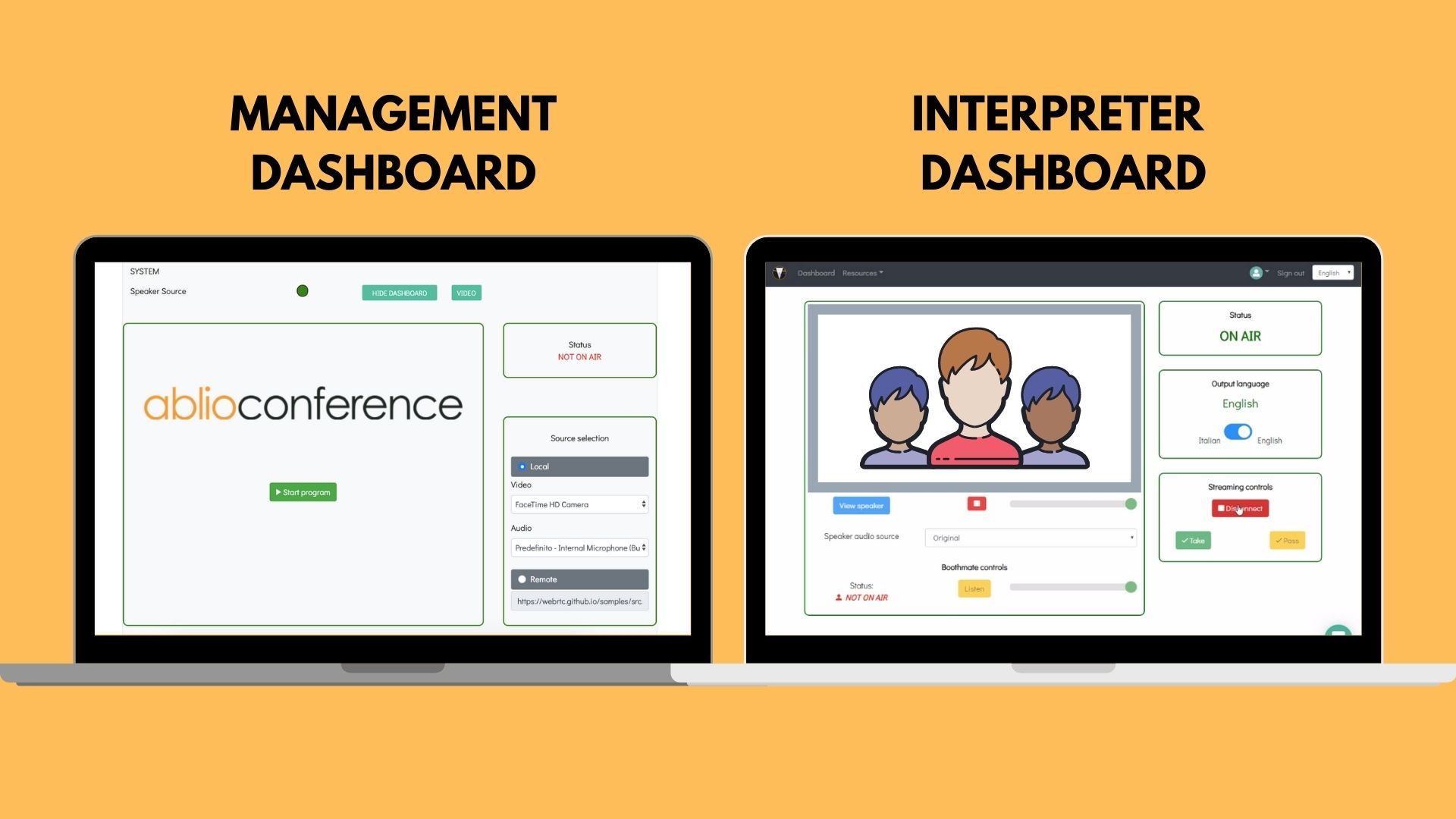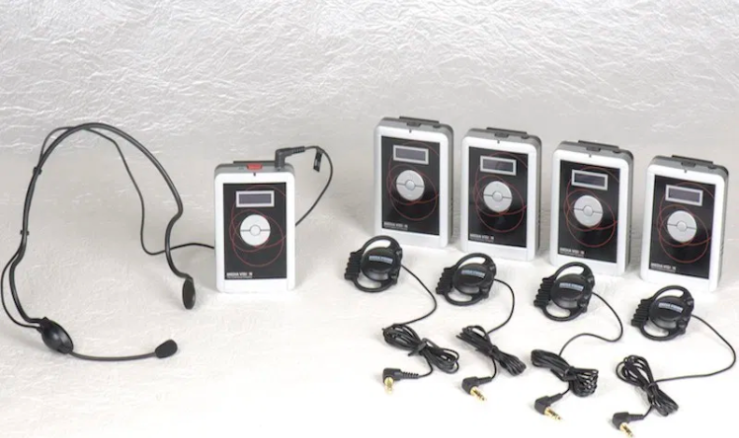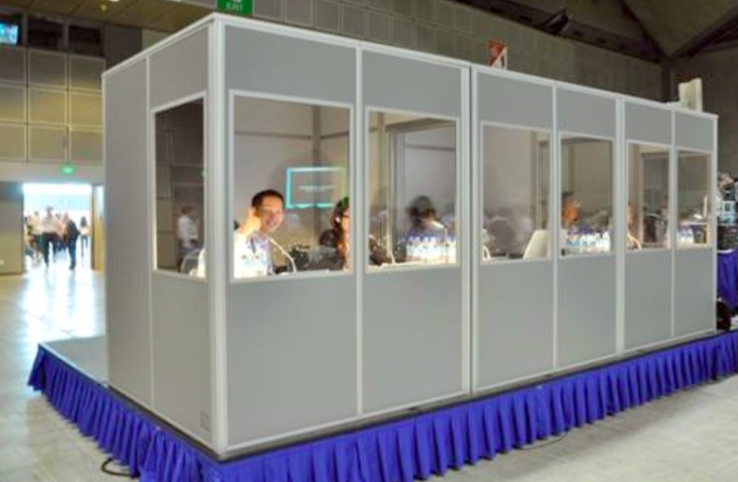Your complete “how-to” guide for simultaneous interpretation at your live and virtual events

SIMULTANEOUS INTERPRETING
Simultaneous interpreting (also commonly referred to as simultaneous translation) is a form of language interpretation that allows you to hear a spoken translation of the speaker’s source language at the same time as the speaker is speaking. This means that the speaker does not have to pause and wait for the simultaneous interpreter to deliver their translation - which is what happens when using the alternative mode, known as consecutive interpreting. Simultaneous Interpreters. Operating in simultaneous interpreting mode is a demanding task for interpreters: besides mastering both source and target languages, they need to be proficient in understanding the subject matter in order to accurately and continuously orally translate at the speaker's pace. Only professionally trained and highly skilled interpreters are able to operate in this simultaneous interpretation mode. While no officially recognized standards exist for this profession, there are several highly reputable Interpreters’ Associations, such as AITI and AITC, who provide established standards, training courses and examinations, leading to certification of their qualified members. Their websites also allow to search and contact their members. Engaging conference interpreters provided with such certificates is usually a guarantee of their professionalism and competencies. Conference interpreters normally operate in pairs when they are required to interpret sessions lasting longer than one hour. This allows them to take turns and assist each other during the performance of their services. If you are interested in knowing more about simultaneous interpreting and the background to this profession, you can read this interesting report, written by Daniel Gile, Universitè de la Sorbonne, Paris, downloadable from the ResearchGate website at this link: https://www.researchgate.net/publication/328028446_2018_Simultaneous_interpreting/link/5bb3924e299bf13e605ad93d/download
Simultaneous translation equipment - FOR LIVE EVENTS

Since the speaker and the simultaneous interpreter are talking at the same time without pause, those listening to the interpreter have to be able to hear the interpreter's voice clearly through personal headsets. This allows them to follow the simultaneous translation by focusing solely on the audio feed to their headsets. This also means that the speaker is not disturbed by the interpreter's voice. Simultaneous interpretation sessions therefore involve the use of equipment which handles the parallel communications between speakers, interpreters and listeners. In a typical Simultaneous interpretation session, each listener is provided with a radio receiver device with a headset for listening to the translation audio, while the interpreters have equipment that enables them to listen to the speaker's voice and simultaneously translate it for the audience through a microphone. First attempts to design simultaneous interpreting equipment started in the 1920s: one of the notable early uses in practice was during the famous post-war Nuremberg trials in 1945. There are many types of simultaneous interpretation equipment available on the market today that can be used simultaneous translation. These can be grouped into three main categories, based upon the telecommunications technology used to distribute the translation audios to the listeners: radio infrared; bidule (unlicensed radio); and the internet. Radio Infrared systems Radio Infrared technology uses light to convey data from sender to receiver, and is widely used in many applications, such as TV remote controls. Simultaneous interpreting systems based upon this technology comprise a number of devices performing different tasks: a control unit which manages the flow of all audio streams; the interpreters’ consoles; radiant panels which are placed around the audience for distributing the audio stream from interpreters to the audience; and the listeners’ receivers with attached headsets, which receive the translated audio stream that is conveyed via the radiant panels. These systems are modular, supporting any kind of venue size and number of listeners, with capacity for multiple language channels. The audio signals don't suffer from interference, and privacy is ensured since they do not pass through the venue's walls. These qualities do, however, come at a cost: the equipment is expensive as it can only be used for this dedicated purpose, and requires time-consuming setup work at each event, which must be performed by skilled technicians in order to ensure reliable performance.
Bidule radio devices

Bidule devices use radio frequency in the unlicensed UHF radio spectrum as the medium of telecommunication between interpreters and listeners. This is the same technology that is used in domestic walkie-talkie devices, with the simultaneous interpreter handling a transmitting device and the listeners receiving translation audio on individual receivers. Compared with simultaneous interpretation infrared-based systems, such devices have several limitations, but have the advantage of being simpler to use, and avoiding the need for any setup. They usually provide a good fit for events with one or two language channels and small groups of listeners. Internet based solutions.
There are several technologies, such as WEB-RTC, A/V-over-IP and streaming, that are capable of handling audio/video communications between devices through the Internet, Wi-Fi and mobile networks. Recently several companies have developed software applications capable of handling simultaneous translation that take advantage of these technologies. Nowadays these apps can be implemented using mobile devices. Unlike the other simultaneous interpretation solutions, they don't require any specific simultaneous interpreting equipment, since the simultaneous interpreters are able to operate using standard laptop computers, and listeners can receive their translation feeds on their own personal smartphones which function as receivers (known as BYOD technologies). Moreover, with these systems the simultaneous interpreters can operate on-site or be remotely connected, while in the other options they must be present at the event itself. Since they rely on the Internet as a communications carrier, proper Internet connectivity has to be ensured at the venue itself.
Simultaneous translation equipment rental and management
Since the traditional form of simultaneous interpreting equipment is expensive and dedicated to a single specific task, few venues are equipped with a permanent simultaneous interpretation system (normally only belonging to large organizations like the United Nations or the European Parliament). Otherwise they have to be rented through specialized technical service providers - who will supply them in the required quantities and take care of their setup, configuration and management throughout the event. Most providers of the standard A/V equipment needed for an event will also be able to supply them.

On-site Simultaneous Interpreters usually operate in “simultaneous interpreting booths”: soundproof cabins which ensure optimal sound quality and avoid disturbing the audience. These booths also have to be rented and installed at the venue. Having opted for radio infrared or Bidule interpreting solutions, appropriate staff will be needed to organize the distribution of the headset receivers to the participants (as well as their collection at the end of the event). As these receivers are expensive the staff will need to use appropriate tracking methods to ensure no devices fail to be returned or get lost.
Trends - Are computers going to replace human interpreters?
Automatic speech recognition technology is steadily advancing, and the performance of dictation software nowadays is impressive. Automatic translation has also made spectacular progress. Combining these technologies will potentially enable the provision of quasi-simultaneous translation of speech, but the quality of its output will remain far below that of human simultaneous interpreting because of errors in speech recognition, semantic interpretation and voice synthesis. Such options may develop for specialized purposes and settings, but are less likely to be popular at events where natural style of communication is important. No matter how advanced technological development becomes, human simultaneous interpreters will always be needed certain market segments, in particular in political speeches, business conferences, debates, and in the media. The devices that have been used in providing interpretation have traditionally been based upon radio infrared or bidule technologies and have remained pretty much unchanged over recent decades, except for miniaturization and the evolution from analog to digital sound.
The Internet-based solutions - which leverage the widespread diffusion of smartphone devices and enhanced telecommunications facilities and services - have been introduced into the market more recently. They are still not widely known, and have so far only been adopted by a small fraction of the market. Nevertheless, since they remove the need for dedicated equipment and on-site interpreters, and provide substantial reductions in rental and labour costs, they offer significant advantages when compared with traditional legacy systems: it's therefore to be expected that they will gradually become the preferred tools for the existing market – as well as opening the door to new customer segments that have so far been excluded because of the high costs involved.
Ablioconference – a complete simultaneous interpreting software solution

Ablioconference is an Internet-based software solution in which interpreters and event organizers operate on standard computers, while audiences listen to the audio translations using their own smartphones. Unlike other similar solutions, Ablioconference does not necessarily rely on existing Wi-Fi networks, since these may offer unpredictable or inadequate performance levels; instead, it enables the creation of its own dedicated network.
Thanks to Ablio’s patented system, this network can efficiently serve hundreds of concurrent users through just one single router. It can either operate as a cloud-based application, or be deployed on-site, running in local mode without the need for any existing Internet connectivity.
Set up a call with our team!

Multilingual Web Conferencing | Remote Interpretation - RSI

Additionally, it can be operated in conjunction with any third-party web conferencing platform to provide the same simultaneous translation services for web-based sessions and conferences. Through their web-based dashboards event organizers are able to configure, setup, test and manage the entire service flow. They can use their own preferred interpreters or choose and engage them by tapping into Ablio’s vast interpreter community - available from within the same Ablioconference service platform.



Using state-of-the-art IT & telecommunication technologies, ablio makes language interpretation services easily available to everyone, in any context, by creating tools and service platforms that are supported by its own community of live interpreters.
For further information please visit our websites:
● ablio.eu – General Website
● ablio.com – OPI Platform
● ablioconference.com – Simultaneous Interpreting Platform



